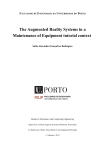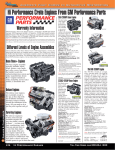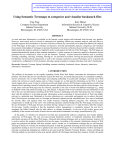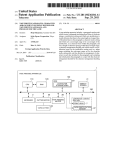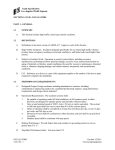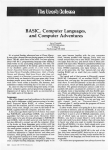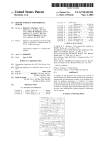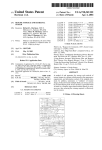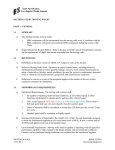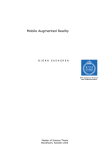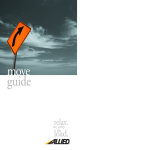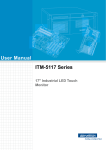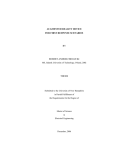Download Augmented reality method and system for designing environments
Transcript
US 20100185529A1 (19) United States (12) Patent Application Publication (10) Pub. No.: US 2010/0185529 A1 Chesnut et al. (54) AUGMENTED REALITY METHOD AND SYSTEM FOR DESIGNING ENVIRONMENTS (43) Pub. Date: Publication Classi?cation (51) AND BUYING/SELLING GOODS (76) Inventors: Int CL G06Q 30/00 G09G 5/00 G06T 1 5/00 Casey Chesnut, Garland, TX (U S); Scott Rudolph, waukeshaa WI (US) Jul. 22, 2010 (52) (200601) (2006.01) (2006-01) US. Cl. .......................... .. 705/27; 345/633; 345/419 (57) ABSTRACT Correspondence Address: Described is a method and a corresponding system for Intellectual Property Dept‘ designing interior and exterior environments and for selling Dewitt Ross & Stevens SC real World goods that appear as virtual objects Within an 2 East Mif?ill street, suite 600 MadiSOIl, WI 53703-2865 (Us) augmented reality-generated design. The method includes the steps of generating a digitized still or moving image of a real World environment; providing in a programmable com puter a database of virtual objects; parsing the image With a programmable computer to determine if the image contains any real World markers corresponding to the virtual objects in (21) APPL NO; 12/691,523 (22) Filed: Jall- 21, 2010 the database; retrieving corresponding virtual objects from Related US Application Data the database and superimposing the images contained in the virtual objects in registration upon their corresponding real World markers in the image; and enabling users to retrieve the (60) Provisional application No. 61/ 146,1 16, ?led on Jan. 21, 2009. attributes of the real World objects depicted in the augmented reality image. ent Application Publicati 0 n ul . 2 2 2 0 1 0 S h e e t 2 0 f 3 Patent Application Publication Jul. 22, 2010 Sheet 3 of3 Fig. 3 US 2010/0185529 A1 US 2010/0185529 A1 AUGMENTED REALITY METHOD AND SYSTEM FOR DESIGNING ENVIRONMENTS AND BUYING/SELLING GOODS CROSS-REFERENCE TO RELATED APPLICATIONS [0001] Priority is hereby claimed to provisional application Ser. No. 61/146,116, ?led Jan. 21, 2009, and incorporated herein by reference. FIELD OF THE INVENTION [0002] The invention is directed to an augmented reality system and a corresponding method for designing interior and exterior environments, and for selling real World goods that appear as virtual objects Within the augmented reality generated design. Jul. 22, 2010 objects and the real objects in an AR environment is the subject of much on-going research. [0007] A typical augmented reality system includes a dis play device and a tracking device With associated softWare housed in a computer. The computer can be of any descrip tionidesktop, laptop, hand-held, mobile, or Wearable com puter. The display device and tracking device may be opera tionally connected to the computer by any means, such as via a hard-Wire connection directly to the computer or to com puter netWork or via Wireless connections. The softWare monitors events detected by the tracking device to determine the present position of the display in the real World and to retrieve virtual objects for use by the user. In order for the display device to present the correct virtual objects, the vir tual objects and the real World must be in registration or otherWise synchroniZed in some fashion. In short, in order for the AR environment to be useful, virtual objects must appear at proper places in the real World so that the user can correctly BACKGROUND determine spatial relationships and orientations. For the AR [0003] Augmented Reality (AR) is a technology that environment to function optimally, registration of the com enhances a person’s vieW of the real World With virtual, com puter- generated graphics must adjust, dynamically and in real puter-generated objects such as stationary and/or moving time, in response to changes in the user’s real World perspec tive. [0008] Several AR systems are described in the patent lit erature. A number of these systems speci?cally address the images, text, data, etc., Which are projected through a video monitor. Unlike virtual reality (VR), Wherein the system places the user in a totally synthetic computer- generated envi ronment, anAR system merges computer-synthesized objects tracking and registration problem When using mobile AR systems. For example, US. Pat. No. 7,274,380, to Naveb et al. With a user’s real World environment, to yield a dynamic environment that is part real and part virtual. Thus, in AR (issued Sep. 25, 2007) describes an augmented reality system systems, the computer-generated graphics interact With, having a very speci?c means for determining registration and supplement, and augment the user’s interactions and percep orientation of the virtual objects With respect to the real objects in the AR environment. Here, the system comprises a tions of a real-World environment. [0004] It is critical to draW a clear distinction betWeen AR environments and VR environments. In a VR environment, video source that resides at a given location and produces an the user interacts With (or is “immersed into”) a three-dimen This encoded marker is formed to store data Within a matrix image. At least one encoded marker resides Within the image. sional environment Which is entirely computer-generated. surrounded by a substantially opaque frame. A marker detec Thus, VR systems are described as being virtual, interactive, tor is then coupled to the video source. The marker detector is adapted to derive encoded data from the marker that resides Within the image. Within the computer is contained a local iZation processor that is adapted to receive data from the and immersive. In sophisticated, computationally demanding versions, the VR environment can be a photorealistic, three dimensional space. But, everything Within the VR environ ment is not real; every object, surface and image is computer generated. Thus, When immersed in a VR environment, the user is incapable of sensing his real World environment. [0005] In contrast, AR systems supplement the real World With virtual, computer-generated objects that appear to co exist in the same space as the real World. Thus, When immersed in anAR environment, the user is fully aWare of his real World environment because the AR- generated objects are layered on top of the user’s real World environment. In effect, AR systems link and combine virtual environments With actual environments in a dynamic, interactive, and real time fashion. The AR softWare generates the virtual objects and their attributes, and juxtaposes images of the virtual objects With images of real objects taken from a real environment. The virtual objects are disposed in registration With speci? cally de?ned real World markers. [0006] This last item, registration, is a notable parameter that must be addressed in AR systems, but is Wholly absent in VR systems. Because VR systems are entirely computer gen erated, they are intrinsically self-orienting; the placement of marker detector and to generate data regarding the location and the orientation of the marker. The localiZation processor then retrieves information from a database that is related to the location and orientation of the marker. The localiZation processor then making the information retrieved from the database available to a user by presenting the information on the monitor in Which the AR environment is presented. The speci?c attribute of this registration system is that the frame of each marker is formed so as to have an exterior edge string and an interior edge string. The localiZation processor calcu lates the relative lengths of the exterior and interior edge strings to establish the presence of a marker Within an image. When the marker is detected, its orientation is determined and the appropriate image is retrieved from the database and superimposed on the marker. [0009] A number of other patents and published patent applications address the problem of hoW to present the virtual objects and the real objects in the proper orientation to each other. See, for example, US. Pat. No. 6,765,569, issued Jul. every virtual object in a VR environment can be de?ned in 20, 2004, to Neumann et al. This patent describes an AR system that uses an auto-calibration feature for rendering computer code With respect to another virtual object. In con trast, an AR system must place the virtual objects in proper annotations into images of a real World scene as the camera moves about relative to the scene. US. Patent Application registration both to other virtual objects generated by the Publication No. US 2007/0 038 944, published Feb. 15, 2007, to Carignano et al., describes an augmented reality system system and to real World objects. Registration of the virtual Jul. 22, 2010 US 2010/0185529 A1 having means for gathering image data of a real environment, means for generating virtual image data from the image data, its corresponding real World object, as Well as attributes of the means for identifying a prede?ned marker object of the real environment based on the image data, and means for super imposing a set of object image data With the virtual image data at a virtual image position corresponding to the pre de?ned marker object. A similar AR system is described in US. Patent Application Publication No. US 2007/0 202 472, published Aug. 30, 2007, to Moritz. See also US. Pat. No. cost, compatibility, etc.) The digital image is parsed With a programmable computer to determine if the image contains any real World markers corresponding to the virtual objects in the database;. Any corresponding virtual objects are then retrieved from the database. The images encoded by the vir corresponding real World object (e.g., make, model, siZe, tual objects are superimposed in registration upon their cor responding real World markers in the image, thereby gener 7,204,428, issued Apr. 17, 2007, to Wilson. This object iden ti?cation system operates using infrared video. In this ating an augmented reality image. Users are then enabled to retrieve the attributes of the real World objects depicted in the approach, a coded pattern applied to an object is identi?ed When the object is placed on a display surface of an interactive display. The coded pattern is detected in an image of the programming the computer to display the attributes of the real display surface produced in response to re?ected infrared (IR) light received from the coded pattern by an IR video camera disposed on an opposite side of the display surface from the object. [0010] The coded pattern can be either a circular, linear, augmented reality image. This can be done, for example, by World item When a computer cursor is scrolled over each virtual object in the augmented reality image. [0014] The invention also includes a corresponding system for designing interior and exterior environments and for sell ing real World goods that appear as virtual objects Within an matrix, variable bit length matrix, multi-level matrix, black/ augmented reality-generated design. The system comprises a digital imaging device con?gured to generate a digitiZed still White (binary), or gray scale pattern. [0011] AR softWare components are commercially avail or moving image of a real World environment. The imaging able. ARToolWorks, Inc., Seattle, Wash., for example, mar puter having stored therein a database of virtual objects Wherein each virtual object corresponds to at least one real World marker. Each virtual object depicts a real World object for sale, and each virtual object encodes an image of its corresponding real World object and attributes of the corre sponding real World object. A comparator program is stored kets a sofWare library called “ARToolKit.” The softWare is made available through a GNU general public license, and through more restrictive licensing terms for commercial applications. ARToolKit is a softWare library for building AR applications. It is not, itself, an AR application, but rather a tool kit for building AR environments. The ARToolKit soft Ware suite addresses one of the key di?iculties in developing AR applications: the problem of tracking the user’s vieW point. To knoW from What vieWpoint to draW the virtual imagery, the application needs to knoW Where the user is looking in the real World. The ARToolKit uses physical, dis tinguishable markers in the real World to calculate the real camera position and orientation relative to physical markers in real time. The softWare is distributed on-line With the complete source code and alloWs (in current versions) for single camera position and orientation tracking. The ARTool Kit softWare tracks the virtual objects to the real World mark ers fast enough to be considered real time. device is operationally connected to a programmable com in the programmable computer. The comparator is con?gured to parse images generated by the imaging device to determine if the images contain any real World markers corresponding to the virtual objects in the database. A retrieval program is provided and con?gured to retrieve corresponding virtual objects from the database. A merging unit superimposes the images contained in the virtual objects in registration upon their corresponding real World markers in the image gener ated by the imaging device, thereby generating an augmented reality image. A display device is provided and con?gured to enable users to retrieve the attributes of the real World objects depicted in the augmented reality image. [0015] In the method and the system, the digital imaging [0012] VR systems for three-dimensional interior design are knoWn and commercially available. See, for example, device may be selected from the group consisting of a digital US. Pat. No. 7,277,572, issued Oct. 2, 2007, to MacInnes et al., and the references cited therein. This patent describes a like. The attributes of the corresponding real World objects encoded by each virtual object may selected from the group consisting of cost to purchase, cost to ship, physical dimen method for generating and rendering a photorealistic, three dimensional perspective vieW of a three-dimensional object selectively positioned Within a three-dimensional scene. Commercially available VR softWare packages for interior design include “Custom Home 3-D Design & Decor” (Sierra, Inc.), “5-in-1 Home Design” (Punch! Software LLC), and “3D Home Interiors” (Broderbund). SUMMARY OF THE INVENTION [0013] The invention is thus directed to a method and a corresponding system for designing interior and exterior still camera, a digital movie camera, a digital scanner, and the sions, siZing, color, texture, Weight, availability, poWer requirements, electronic compatibility With other real World objects, country of manufacture, combinations thereof, and the like. The real World markers may be selected from the group consisting of circular, linear, matrix, variable bit length matrix, multi-level matrix, black/White (binary), gray scale patterns, tWo- or three-dimensional codes, tWo-or three-di mensional renderings of real World, three-dimensional objects, and combinations thereof. All of the foregoing lists are exemplary and non-limiting. environments and for selling real World goods that appear as virtual objects Within an augmented reality-generated design. BRIEF DESCRIPTION OF THE DRAWINGS The method comprises generating a digitiZed still or moving image of a real World environment. Provided in a program [0016] mable computer is a database of virtual objects Wherein each virtual object has at least one corresponding real World marker. Each virtual object describes and/or depicts a real World object for sale. Each virtual object encodes an image of markers that can be used in the present invention. [0017] FIG. 2 depicts an AR vieW of the real World markers FIG. 1 depicts a series of exemplary real World as shoWn in FIG. 1 having virtual objects superimposed thereon to yield an AR environment. US 2010/0185529 A1 [0018] FIG. 3 is a schematic rendering of an AR system according to the present invention. DETAILED DESCRIPTION OF THE INVENTION [0019] The invention is an AR system and a corresponding method for designing interior and exterior environments, and for selling real World goods that appear as virtual objects Within the augmented reality- generated design. [0020] The system comprises a number of components for generating the AR environment. The ?rst component is a Jul. 22, 2010 a virtual object, or a quality of a virtual object (eg the obj ect’s color, texture, opacity, etc.) or both the virtual object itself and all (or a subset) of the qualities of the virtual object. [0023] The system further includes an AR library (ie a database of virtual objects), a computer that can selectively search and access the library, and a video monitor dimen sioned and con?gured to display the real World digital image captured by the camera, as Well as virtual objects retrieved from the AR library. On the computer is stored a search and return engine that links each unique real World marker to a camera or other video input to generate a digitiZed video corresponding virtual object in the AR library. image of the real World. For brevity, this component Will [0024] In operation, the camera returns a digital video stream of the real World, including images of one or more of simply be referred to as a camera. The camera may be any digital device noW knoW or developed in the future that is dimensioned and con?gured to capture still or motion pic tures of the real World and to convert those images to a digital stream of information that can be manipulated by a computer. For example (and by Way of an exemplary and non-limiting the markers described previously. Image samples are taken from the video stream and passed to the computer for pro cessing. The search and return engine then searches the AR library for the virtual objects that correspond to the marker images contained in the digital video stream of the real World. list), the camera may be a digital still camera, a digital video Once a match is made betWeen a real World marker contained camera, a Web cam, a head-mounted display, a camera phone, in the digital video stream and the AR library, the AR library Will return the virtual object, its qualities, and its orientation to the video monitor. The virtual object is then superimposed upon the real World image. The virtual object is placed into a tablet personal computer, an ultra mobile personal com puter, and the like. The nature of the camera is not critical to the functionality of the invention so long as the camera ren ders a digital image or stream of images of the real World. [0021] “Computer” as used herein means any electronic the real World image registration With its corresponding device that is specially and permanently programmed to marker. Multiple markers may be used to position and orient a single virtual object. For example, four unique markers execute the method described herein (either via softWare could be used to construct the virtual Walls of a virtual room. code, hardWare-implemented code, ?rmware-implemented [0025] In other Words, the search and return engine parses the real World image to determine if it contains a marker. If the real World image does contain a marker, the AR library is queried to return the virtual object that corresponds to the real World marker. The virtual object is returned to a video merg ing unit (that may be a separate unit or an integral part of the computer) that merges the real Word image With the virtual code, or any combination thereof) or any electronic device that can be programmed to execute the method described herein (again via softWare, hardWare, ?tinWare, or any com bination thereof), including (by Way of example and not limi tation), a single (or multiple) processor-based system that may be supported in a stand-alone (desktop, laptop, personal digital assistant), networked, mainframe, or client-server architecture, or other computing environment. The system used to execute the method may including one or more knoWn storage devices (e.g., Random Access Memory (RAM), Read Only Memory (ROM), hard disk drive (HDD), ?oppy drive, tape drive, compact disk/Write-read-ROM, DVD, bubble memory, etc.), and may also include one or more memory devices embedded Within a processor, or shared With one or more of the other components. The computer programs or algorithms described herein may easily be con?gured as one or more hardWare modules, and (vice-versa) any hardWare modules shoWn may easily be con?gured as one or more image retrieved from the AR library. The virtual object may be tWo-dimensional or three-dimensional, preferably three dimensional. At a minimum, the AR library returns the virtual object, as Well as its position and orientation Within the real World image (Which is dictated by the position and orientation of the corresponding marker in the real World image). The AR library may also return information pertaining to the nature, cost, dimensions, or any other quality about the item depicted in the virtual object. The virtual object is then rendered on top of its corresponding real World marker according to the mark er’s position and orientation so that the virtual object appears in place of (or superimposed upon) the real World marker. [0026] In the preferred version of the invention, the virtual softWare modules Without departing from the invention. [0022] The next component of the system is a series of unique real World markers. The markers can be of any design, noW knoWn or developed in the future, including a circular, (chairs, couches, tables, etc.), kitchen appliances (stoves, refrigerators, dishWashers, etc.), of?ce appliances (copy objects represent real World products such as furniture linear, matrix, variable bit length matrix, multi-level matrix, machines, fax machines, computers), consumer and business black/White (binary), gray scale patterns, and combinations electronic devices (telephones, scanners, etc.), fumishings thereof. The markers can be tWo-dimensional or three-dimen sional. The markers can be tWo- or three-dimensional bar (pictures, Wall hangings, sculpture, knick knacks, plants), ?xtures (chandeliers and the like), cabinetry, shelving, ?oor codes, or tWo-or three-dimensional renderings of real World, three-dimensional objects. For example, the markers may be thumbnail images of the virtual images that Will be matched coverings (tile, Wood, carpets, rugs), Wall coverings, paint recogniZe a refrigerator or other appliance from a video stream of a kitchen. The softWare then superimposes a virtual colors, surface textures, countertops (laminate, granite, syn thetic countertops), electrical and telecommunication jacks, audio-visual equipment, speakers, hardWare (hinges, locks, door pulls, door knobs, etc.), exterior siding, decking, Win doWs, shutters, shingles, banisters, neWels, hand rails, stair steps, landscaping plants (trees, shrubs, etc.), and the like, and qualities of all of these (e.g. color, texture, ?nish, etc.). The object in place of the real World refrigerator. Each unique real World marker (as described more fully beloW) corresponds to real World vieW is a preferably a picture of a consumer’s home or Work environment (interior or exterior) that he Wishes to to the markers. The marker may also be an image of a real World item Which the softWare has been programmed to rec ogniZe. So, for example, the softWare can be programmed to Jul. 22, 2010 US 2010/0185529 A1 design to his liking. The AR system is then used to render an AR environment comprising the user’s chosen real World oriented and placed in registration in place of or superim posed upon the markers present in the real World image sent location, augmented by virtual objects selected by the user to the video merging module 16 via connector 22. The result and representing real World durable and/ or consumable goods that are available for purchase by the user. [0027] The system is better understood With reference to connector 26 to monitor 30 for vieWing. the attached draWings, Where the same reference numerals are used throughout the ?gures to represent the same elements. [0028] FIG. 1 is a schematic rendering of a real World environment 50 having placed therein four real World, unique markers, 1, 2, 3, and 4. The patterns on the four markers are for illustration only and are non-limiting. As noted above, the patterns used on the markers to render the markers unique can be any pattern or code noW knoWn or developed in the future. For purposes of illustration, the four markers depicted in FIG. ing superimposed image, noW an AR image, is exported via [0032] The image generated could appear, for example, as shoWn in FIG. 2. In FIG. 2, the real World is depicted by rectangle 50, While the augmented, virtual objects are depicted as three-dimensional cubes 1', 2', 3', and 4'. Note that the virtual cubes 1', 2', 3', and 4' are generated in registration With the real World markers 1, 2, 3, and 4 as depicted in FIG. 1. [0033] FIG. 2 is for purposes of illustration only. The vir tual objects 1', 2', 3', and 4' could be images of any real World 1 are all different from one another. The same marker, hoW ever, may appear an unlimited number of times in any real object, as listed earlier. World environment 50. Each unique marker, hoWever, is gen AR system to designAR environments and then to sell the real erally assigned its oWn corresponding unique virtual object. World goods represented by the virtual objects presented in This, hoWever, is preferred, and not mandatory. The concor dance betWeen the real World markers and their correspond ing virtual objects may be linked in any logical fashion dic the AR environment. Thus, a typical implementation of the invention might proceed as folloWs: [0035] A home improvement store, or “do-it-yourself’ tated by the needs of the user (e.g, in classes or sub-classes according to siZe, function, color, etc.). Thus, for example, [0034] The method of the invention comprising using the type store Would have set aside a kiosk or other area having a one marker may represent a unique make of refrigerator in a system as depicted in FIG. 3 set up for customers’ use. A speci?ed color, While another marker may represent the same customer Would then bring to the store a digital image of, say, make of refrigerator, but in a different color. Or a marker may represent that same make of refrigerator in any color, With a his kitchen. This digital image Would be the real World image second marker being used to provide the color of the refrig erator designated by the ?rst marker. For purposes of brevity, it Will be assumed that the four markers 1, 2, 3, and 4, are linked to four different virtual objects, and that those four virtual objects are three-dimensional renderings of real World goods, such as, for example, a refrigerator, a stove, a dish 50 as shoWn in FIG. 3. The real World image Would then be placed in vieW of the camera 10. Markers are then placed on the image 50 to represent neW features that could be incorpo rated into the buyer’s kitchen. Thus, in place of the existing refrigerater, stove, and dishWasher, markers Would be placed. The markers are linked to virtual objects Which are three The system itself is depicted schematically in FIG. dimensional pictures of neW appliances that the seller either has in stock for immediate delivery or Which can be special ordered. In this fashion, the consumer can experiment With a 3. In FIG. 3, a camera 10 is operationally connected to a host of markers representing any aspect of his kitchen design: computer 14, on Which is stored the AR library 12. The link betWeen the camera 10 and the computer 14 is established by from major appliances, to neW cabinets, to neW countertops, to counter-top appliances such as coffee makers, stand mix ers, microWave ovens, blenders, bread makers, etc. Washer, and a television. [0029] connector 20. The connector can be any type of connector noW knoWn or developed in the future for transmitting the digital images from the camera 10 to the computer 14, includ ing both hardWire connectors and Wireless connectors. The same too applies to connectors 22, 24, and 26, Which shall be discussed in turn. [0030] The camera 10 is likeWise operationally connected, via connector 22, to a video merging module 16, Which for purposes of illustration only is shoWn as a separate unit in FIG. 3. In most instances, the video merging module 16 is integrated into the computer 14. The output from the video merging module 16 is transmitted to monitor 30, Which is operationally connected to the video merging module 16 by [0036] Because the AR virtual objects are placed in regis tration With the markers in the real World vieW, and in the proper orientation, the real World inter-relationships of the user’s real World environment and the real goods represented by the virtual objects can be assessed. For example, seem ingly simple questions can be ansWered While the user is in the store. For example, “Will this speci?c coffee maker ?t underneath the existing kitchen cabinets?” If the buyer did not take the height measurement betWeen his existing countertop and the bottom edge of the existing cabinet, the question connector 26. cannot be ansWered Without either returning home to take the measurement, or buying the coffee maker and hoping it ?ts. (And coming back to the store to exchange it for another [0031] coffee maker if the ?rst one does not ?t.) Still referring to FIG. 3, the camera 10 takes a still or moving image of real World environment 50 that includes markers 1, 2, 3, and 4. This image is exported by the camera to both the computer 14, and the video merging module 16. The search and return engine Within the computer 14 then scans the digital video bit stream arriving via connector 20 to determine if the real World image contains any markers. Because markers 1, 2, 3, and 4 are present in the real World image, the computer 14 retrieves the corresponding virtual objects from AR library 12. The retrieved virtual objects are then exported to the video merging module, Where they are [0037] Equally important, the system Will not only return virtual images of real World objects, the virtual objects may also have embedded Within them a Wealth of information about each real World object. Again, taking the example of a kitchen, the user may place objects representing the three major kitchen appliances: refrigerator, oven/stove/range, and dishWasher. The virtual object representing each of these appliances may also have embedded Within it the actual physical dimensions of each appliance, the available colors, the con?gurations available (e. g., gas or electric oven; left or Jul. 22, 2010 US 2010/0185529 A1 right opening fridge door; freezer on top, freeZer on bottom, or side-by-side con?guration), the electricity requirements of the appliances, etc. [0038] The AR system thus alloWs the buyer to experiment (c) parsing the image of step (a) With a programmable using a real World image of the actual environment he Wishes to design or otherWise change. This is a huge boon to the buyer. Rather than trusting to fate that the oven or sink Will actually look pleasing once installed, he can see What it Will actually look like installed, Without even leaving the store. For the seller, it alloWs them to tailor their inventory on the ?y to changing consumer tastes. Perhaps more importantly, it (d) retrieving corresponding virtual objects from the data acts as a tool to limit returns to the store caused by ill-?tting appliances and ?xtures, or due simply to consumer dissatis faction With the item once the user took it out of the box When they got home. Too many items have been returned to too many stores because the buyer felt that the item Was not What he expected at the time the purchase Was made. Using the AR system of the present invention, the buyer can see exactly What the item Will look like, in its intended environment, before the purchase is even consummated. If the buyer is happy after vieWing the object in the present AR system, and the purchase is consummated, the purchase is far more likely to stay consummated. [0039] As the old adage goes, potential buyers like to buy, but they hate to be sold. The present system alloWs buyers to explore their options carefully, in real time and in real space, but using virtual objects. Thus, buyers are given a measure of comfort and certainty that their major (and minor) purchases are, in fact, the right purchases in vieW of the available alter natives. They themselves, using the present system, are enabled to vieW the alternatives and evaluate them in an AR space. [0040] The preferred softWare for generating the AR virtual objects and matching them to the real World markers is the ARToolKit, mentioned previously. This body of AR tools provides a straightforWard frameWork for creating real-time AR applications. The modules Will function across a Wide variety of operating systems, including WindoWs, Linux, Mac OS X, and SGI. The tools overlay the three-dimensional virtual objects on the real World markers based on a computer vision algorithm that accounts for both the position and ori entation of the marker. The softWare Will support multiple computer to determine if the image contains any real World markers corresponding to the virtual objects in the database; and then base and superimposing the images contained in the virtual objects in registration upon their corresponding real World markers in the image of step (a) to generate an augmented reality image; (e) enabling users to retrieve the attributes of the real World objects depicted in the augmented reality image. 2. The method of claim 1, Wherein step (a) comprises generating a digitiZed still image of a real World environment. 3. The method of claim 2, Wherein in step (b) each virtual object encodes a tWo-dimensional image of its corresponding real World object. 4. The method of claim 2, Wherein in step (b) each virtual object encodes a three-dimensional image of its correspond ing real World object. 5. The method of claim 2, Wherein in step (b) each virtual object encodes attributes of the corresponding real World object selected from the group consisting of manufacturer, model designation, purchase price, physical dimensions, Weight, color, texture, country of manufacture, availability in inventory, shipping cost to user’s location, product-speci?c requirements, compatibility With other real World objects, user manual, and combinations thereof. 6. The method of claim 2, Wherein step (e) comprises enabling users to retrieve the attributes of the real World objects on a netWorked computer, a personal digital assistant, a cell phone, or an lntemet-enabled Wireless device. 7. The method of claim 2, Wherein step (c) comprises parsing the image of step (a) for real World markers selected from the group consisting of circular, linear, matrix, variable bit length matrix, multi-level matrix, black/White (binary), gray scale patterns, tWo- or three-dimensional codes, tWo-or three-dimensional renderings of real World objects, and com binations thereof. 8. The method of claim 1, Wherein step (a) comprises generating a digitiZed moving image of a real World environ ment. to link them to real World markers. Suitable programs include, 9. The method of claim 8, Wherein in step (b) each virtual object encodes a tWo-dimensional image of its corresponding real World object. 10. The method of claim 8, Wherein in step (b) each virtual object encodes a three-dimensional image of its correspond for example, osgART (HIT Lab NZ, Christchurch, NeW ing real World object. Zealand). 11. The method of claim 8, Wherein in step (b) each virtual object encodes attributes of the corresponding real World object selected from the group consisting of manufacturer, camera tracking, so that AR images can be generated from more than one camera at more than one point of vieW. [0041] Other commercially available AR tool softWare packages may also be used to generate the virtual objects and What is claimed is: 1. A method for designing interior and exterior environ ments and for selling real World goods that appear as virtual model designation, purchase price, physical dimensions, objects Within an augmented reality-generated design, the method comprising: tory, shipping cost to user’s location, product-speci?c requirements, compatibility With other real World objects, (a) generating a digitiZed still or moving image of a real World environment; (b) providing in a programmable computer a database of virtual objects Wherein each virtual object has at least one corresponding real World marker, Wherein each vir tual object depicts a real World object for sale, and fur ther Wherein each virtual object encodes an image of its corresponding real World object and attributes of the corresponding real World object; then Weight, color, country of manufacture, availability in inven user manual, and combinations thereof. 12. The method of claim 8, Wherein step (e) comprises enabling users to retrieve the attributes of the real World objects on a netWorked computer, a personal digital assistant, a cell phone, or an lntemet-enabled Wireless device. 13. The method of claim 8, Wherein step (c) comprises parsing the image of step (a) for real World markers selected from the group consisting of circular, linear, matrix, variable bit length matrix, multi-level matrix, black/White (binary), Jul. 22, 2010 US 2010/0185529 A1 gray scale patterns, tWo- or three-dimensional codes, tWo-or a display device con?gured to enable users to retrieve the attributes of the real World objects depicted in the aug three-dimensional renderings of real World objects, and com binations thereof. 14. A system for designing interior and exterior environ ments and for selling real World goods that appear as virtual device is selected from the group consisting of a digital still objects Within an augmented reality-generated design, the camera, a digital movie camera, and a digital scanner. system comprising: 16. The system claim 14, Wherein the real World markers are selected from the group consisting of circular, linear, a digital imaging device con?gured to generate a digitiZed still or moving image of a real World environment, the imaging device operationally connected to; a programmable computer having stored therein a database of virtual objects Wherein each virtual object corre sponds to at least one real World marker, Wherein each virtual object depicts a real World object for sale, and further Wherein each virtual object encodes an image of its corresponding real World object and attributes of the corresponding real World object; a comparator program stored in the programmable com puter and con?gured to parse images generated by the imaging device to determine if the image contains any real World markers corresponding to the virtual objects in the database; a retrieval program con?gured to retrieve corresponding virtual objects from the database and a merging unit to superimpose the images contained in the virtual objects in registration upon their corresponding real World markers in the image generated by the imaging device, thereby generating an augmented reality image; mented reality image. 15. The system of claim 14, Wherein the digital imaging matrix, variable bit length matrix, multi-level matrix, black/ White (binary), gray scale patterns, tWo- or three-dimensional codes, tWo-or three-dimensional renderings of real World, three-dimensional objects, and combinations thereof. 17. The system claim 14, Wherein each virtual object encodes a tWo-dimensional image of its corresponding real World object. 18. The system claim 14, Wherein each virtual object encodes a three-dimensional image of its corresponding real World object. 19. The system claim 14, Wherein each virtual object encodes attributes of the corresponding real World object selected from the group consisting of manufacturer, model designation, purchase price, physical dimensions, Weight, color, texture, country of manufacture, availability in inven tory, shipping cost to user’s location, product-speci?c requirements, compatibility With other real World objects, user manual, and combinations thereof. * * * * *










